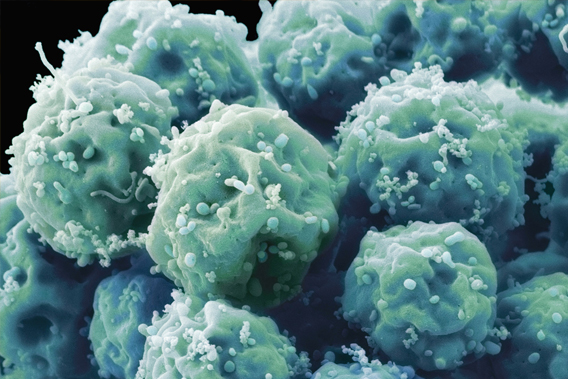Stem Cell Breakthrough
Researchers grow tissues that closely mimic layers of skin and open the possibility for new ways to study diseases and potential drug therapies
By Jacqueline Mitchell
When the National Institutes of Health released new guidelines in July that removed barriers to the responsible use of human embryonic stem cells in research, there was a frisson among American scientists who work with these promising cells.
Count Jonathan Garlick, head of Division of Cancer Biology and Tissue Engineering at the School of Dental Medicine, and his research team among them. Earlier this year Garlick’s lab was the first to grow multilayered tissues from human embryonic stem cells. These novel tissues closely mimic the top two layers of skin or oral tissues, and provide an invaluable model to study all kinds of oral diseases and potential drug therapies for them.

“It’s an exciting time in the field. I am surprised every day that we can do this,” says researcher Jonathan Garlick. “The implications for the future of human health are dramatic.” Photo: Corbis
Human embryonic stem cells are powerful biomedical research tools because of what scientists call their pluripotency—their ability to give rise to all of the human body’s cell and tissue types. Garlick’s team used an NIH-sanctioned line of embryonic stem cells (the cells okayed for federal research funding by the Bush administration in 2001) to grow two separate populations of cells: ectodermal cells, which comprise the top, protective layer of skin and oral tissues, and mesenchymal cells, the second, supportive layer in the skin and mouth.
When the scientists seeded the two cell types onto the same three-dimensional scaffold made of collagen, the most abundant protein in skin and the mouth, the cells organized themselves into naturalistic, multilayered tissues within two weeks. Led by first author Kyle J. Hewitt, a graduate student in cell, molecular and developmental biology at the Sackler School, who works in Garlick’s lab, the researchers reported their findings in the online edition of the journal Tissue Engineering (A).
Previously, stem cell investigators were limited to studying single-layer tissues grown as two-dimensional cells in Petri dishes. “We know the world is not flat,” says Garlick, who is also a professor of oral and maxillofacial pathology. “Neither is biology. By using pluripotent stem cells to make three-dimensional tissues that mimic their human counterparts, we are a step closer to a practical therapy for a variety of oral diseases.”
The lab’s success in growing multilayered tissues also advances the researchers’ ultimate goal: to learn how to transplant lab-grown replacement products to repair damaged and diseased tissues in human patients.
The Garlick lab is also building on recent breakthroughs at Kyoto University in Japan and the University of Wisconsin, where researchers were able to make adult skin cells revert to pluripotency with the insertion of just four genes. Since these reverted adult cells, known as induced pluripotent stem cells, share many of the features of embryonic stem cells, their use may allow scientists to circumvent the ongoing ethical debate about the use of human embryonic stem cells in research. The discovery of pluripotent stem cells “shatters the longstanding dogma in biology that the specialized state of adult cells is irreversible,” says Garlick.
Collaborating with Konrad Hochedlinger at Massachusetts General Hospital and Gustavo Mostoslavsky at Boston Medical Center, Garlick’s team is comparing tissues derived from induced pluripotent stem cells to those derived from embryonic stem cells. If the tissues are biologically comparable, induced pluripotent stem cell research could pave the way for patient-specific, personalized medicine. For example, an individual’s own skin cells could be used to generate a customized tissue sample to test the safety and efficacy of pharmaceuticals or even cosmetics.
“It’s an exciting time in the field. I am surprised every day that we can do this,” says Garlick. “The implications for the future of human health are dramatic.”
Jacqueline Mitchell can be reached at jacqueline.mitchell@tufts.edu.


